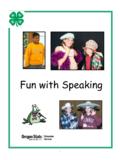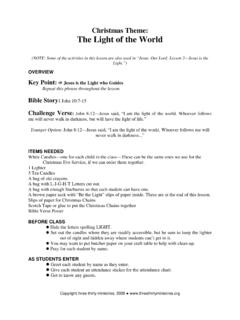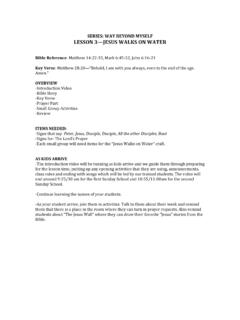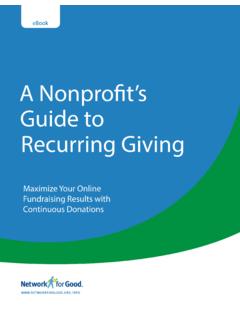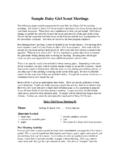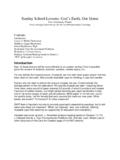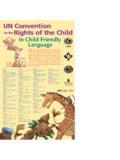Transcription of Basic advice on first aid at work - Health and Safety ...
1 Basic advice on first aid at work This leaflet contains Basic advice on first aid for use in an emergency. It is not a substitute for effective training. This is a free-to-download, web-friendly version of Basic advice INDG37. This version has been adapted for online on first aid at work use from HSE's current printed version. This leaflet contains Basic advice on first aid for use in an emergency. It is not a substitute for effective training. You can buy the book at and most good bookshops. ISBN 978 0 7176 6668 3. Price (Pack of 20). INDG347. Published 2017. What to do in an emergency A Airway Priorities To open the airway: Your priorities are to: place your hand assess the situation do not on the casualty's put yourself in danger; forehead and gently make the area safe; tilt the head back;. assess all casualties and attend lift the chin with two first to any unconscious fingertips. casualties;. send for help do not delay. B Breathing Check for a response Gently shake the casualty's shoulders Look, listen and feel for normal and ask loudly, Are you all right?
2 ' breathing for no more than 10. If there is no response, your priorities seconds: are to: look for chest shout for help; movement;. open the airway; listen at the casualty's check for normal breathing; mouth for breath take appropriate action. sounds;. feel for air on your cheek. If the casualty is breathing normally: place in the recovery position;. get help;. check for continued breathing. Basic advice on first aid at work If the casualty is not breathing remove your mouth from the casualty normally: and watch for the chest falling;. give a second breath and then start get help and call for an AED* 30 compressions again without delay;. if available continue with chest compressions start chest compressions (see CPR). and rescue breaths in a ratio of 30:2. until qualified help takes over or the casualty starts breathing normally. C CPR. Severe bleeding To start chest compressions: If there is severe bleeding: lean over the casualty and with your arms straight, apply direct pressure to the wound.
3 Press down on the raise and support the injured part centre of the breastbone (unless broken);. 5 6 cm, then release apply a dressing and bandage firmly the pressure; in place. repeat at a rate of about Broken bones 100 120 times and spinal injuries a minute;. after 30 compressions open the If a broken bone or spinal injury is airway again; suspected, obtain expert help. If an AED* is available use in Do not move casualties unless they accordance with your training/ are in immediate danger. manufacturer's instructions pinch the casualty's Burns nose closed and allow the mouth Burns can be serious so if in doubt, to open; seek medical help. Cool the affected take a normal breath part of the body with cold water until and place your pain is relieved. Thorough cooling may mouth around the take 10 minutes or more, but this must casualty's mouth, not delay taking the casualty to hospital. making a good seal;. blow steadily into the mouth while Certain chemicals may seriously watching for the chest rising; irritate or damage the skin.
4 Avoid * Where an employer has identified through their needs assessment that they wish to provide an Automated External Defibrillator (AED) in the workplace, then the Provision and Use of Workplace Equipment Regulations 1998 (PUWER) apply. For the purpose of complying with PUWER in these situations the employer should provide information and written instructions for example, from the manufacturer of the AED - on how to use the AED. The Approved Code of Practice (ACOP) and guidance on PUWER (L22 - ) provides information on instructions, maintenance, inspection and the suitability of work equipment. contaminating yourself with the immediately afterwards (eg went chemical. Treat in the same way as for back to work, went home, went other burns but flood the affected area to hospital);. with water for 20 minutes. Continue the name and signature of the person treatment even on the way to hospital, dealing with the incident. if necessary. Remove any contaminated clothing which is not stuck to the skin.
5 This information can help identify accident trends and possible areas for Eye injuries improvement in the control of Health and Safety risks. All eye injuries are potentially serious. If there is something in the eye, wash out the eye with clean water or sterile fluid Further information from a sealed container, to remove loose material. Do not attempt to remove For information about Health and Safety anything that is embedded in the eye. visit or You can view If chemicals are involved, flush the eye HSE guidance online and order priced with water or sterile fluid for at least publications from the website. HSE. 10 minutes, while gently holding the priced publications are also available eyelids open. Ask the casualty to hold a from bookshops. pad over the injured eye and send them to hospital. To report inconsistencies or inaccuracies in this guidance email: Record keeping It is good practice to use a book for This leaflet contains notes on good recording any incidents involving injuries or practice which are not compulsory illness which you have attended.
6 Include but which you may find helpful in the following information in your entry: considering what you need to do. the date, time and place of the This leaflet is available in incident; priced packs from HSE Books, the name and job of the injured ISBN 978 0 7176 6668 3. or ill person;. details of the injury/illness and Crown copyright 2017 Any enquiries any first aid given; regarding this publication should be what happened to the casualty sent to: Revised 2017. INDG347 J003403097 C15 12/17. Published with the permission of the Health and Safety Executive on behalf of the Controller of Her Majesty's Stationery Offic










